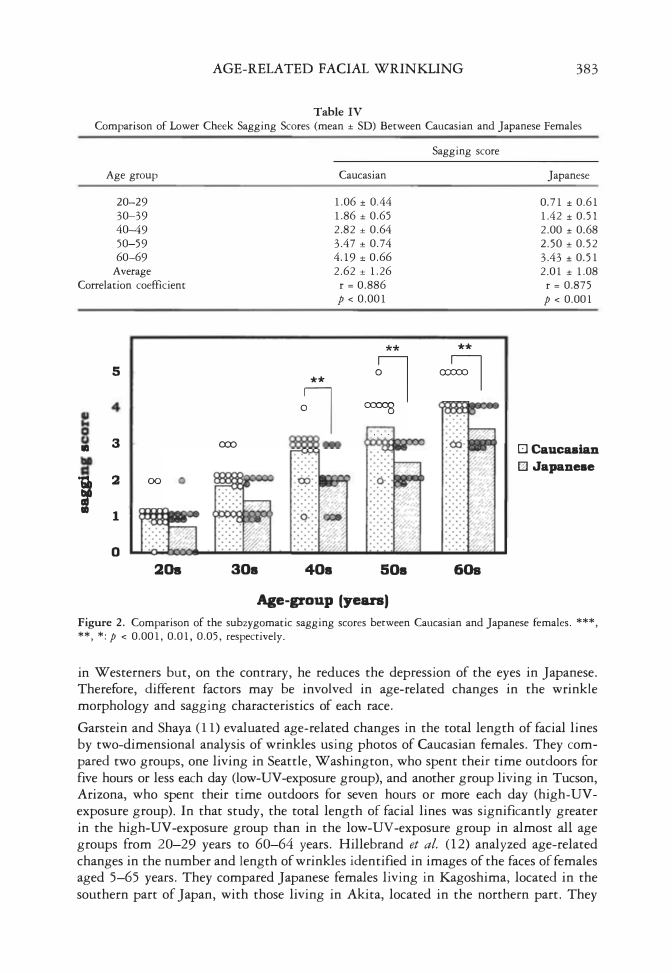AGE-RELATED FACIAL WRINKLING 383 Table IV Comparison of Lower Cheek Sagging Scores (mean± SD) Between Caucasian and Japanese Females Age group 20-29 30-39 4CH:9 50-59 60-69 Average Correlation coefficient 5 3 • 2 ' 00 1 0 20. Caucasian 1.06 ± 0.44 1.86 ± 0.65 2.82 ± 0.64 3.47 ± 0.74 4.19 ± 0.66 2.62 ± 1.26 r = 0.886 p 0.001 ** ** J 07 � . . . CXX) 30a 40a 50a Age-group (years) Sagging score Japanese 0.71 ± 0.61 1.42 ± 0.51 2.00 ± 0.68 2.50 ± 0.52 3.43 ± 0.51 2.01 ± 1.08 r = 0.875 p 0.001 ** � □ Caucasian □ Japanese 60a Figure 2. Comparison of the subzygomatic sagging scores between Caucasian and Japanese females. ***, **, *: p 0.001, 0.01, 0.05, respectively. in Westerners but, on the contrary, he reduces the depression of the eyes in Japanese. Therefore, different factors may be involved in age-related changes in the wrinkle morphology and sagging characteristics of each race. Garstein and Shaya (11) evaluated age-related changes in the total length of facial lines by two-dimensional analysis of wrinkles using photos of Caucasian females. They com pared two groups, one living in Seattle, Washington, who spent their time outdoors for five hours or less each day (low-UV-exposure group), and another group living in Tucson, Arizona, who spent their time outdoors for seven hours or more each day (high-UV exposure group). In that study, the total length of facial lines was significantly greater in the high-UV-exposure group than in the low-UV-exposure group in almost all age groups from 20-29 years to 60-64 years. Hillebrand et al. (12) analyzed age-related changes in the number and length of wrinkles identified in images of the faces of females aged 5-65 years. They compared Japanese females living in Kagoshima, located in the southern part of Japan, with those living in Akita, located in the northern part. They
384 JOURNAL OF COSMETIC SCIENCE Table V Comparison of Wrinkle Score and Sagging Score in Different Facial Skin Sites: Level of Caucasian Scores Compared With Japanese Scores Wrinkling Age Upper Corner of Lower Nasolabial Corner of group Forehead Glabella eyelid the eye eyelid groove Cheek the mouth Sagging 20-29 t t t t t t t t 30-39 t t t t t t t 40-49 t t t t t t t t 50-59 t t t t t t 60---69 � Q q t t t t t : Significantly higher scores than the Japanese females. : Higher scores than the Japanese females (not significantly). q : Level equal to that of the Japanese females. � : Lower scores than the Japanese females (not significantly). observed the same wrinkle levels in 40-year-old females in Kagoshima and 48-year-old females in Akita, suggesting the influence of UV exposure on wrinkle formation. Hu man skin is classified according to UV sensitivity into phototypes I-IV (13). One study, which evaluated the severity of wrinkles by scoring according to four skin types in 230 Japanese males and females aged 40 years or more, showed that subjects with skin types highly sensitive to UV tended to develop deep wrinkles due to photoaging (14). There fore, the amount of UV exposure and skin type may be closely associated with wrinkle formation. In addition to the skin, the skeleton and facial muscles have been reported to be closely involved in the aging of the face (15). We previously obtained wrinkle replicas in eight areas of the face from 136 Japanese females living in Tokyo in ten-year age groups ranging from 18 to 83 years of age, and we evaluated age-related changes in the depth and coarseness of wrinkles by 3D analysis. Although the entire face had been exposed to UV, the degree of wrinkle development differed among areas. We speculated that factors other than UV, namely, mechanical factors such as facial movements and sensitivity to transient wrinkle formation, are the primary causes of wrinkle formation (16). Loth (17) reported differences in anatomical morphology and incidence of facial muscles among races. Therefore, in addition to the amount of UV exposure and skin type, differences in the facial muscles and skeleton may have caused higher wrinkling and sagging scores in the Caucasian females than in the Japanese females. Resolution of this speculation will require further study. This study compared age-related changes in wrinkling and subzygomatic sagging be tween Caucasian females living in North America and Japanese females living in Tokyo.
Purchased for the exclusive use of nofirst nolast (unknown) From: SCC Media Library & Resource Center (library.scconline.org)






































































































